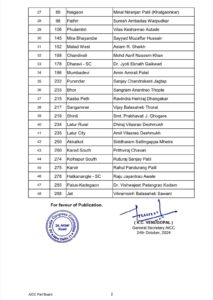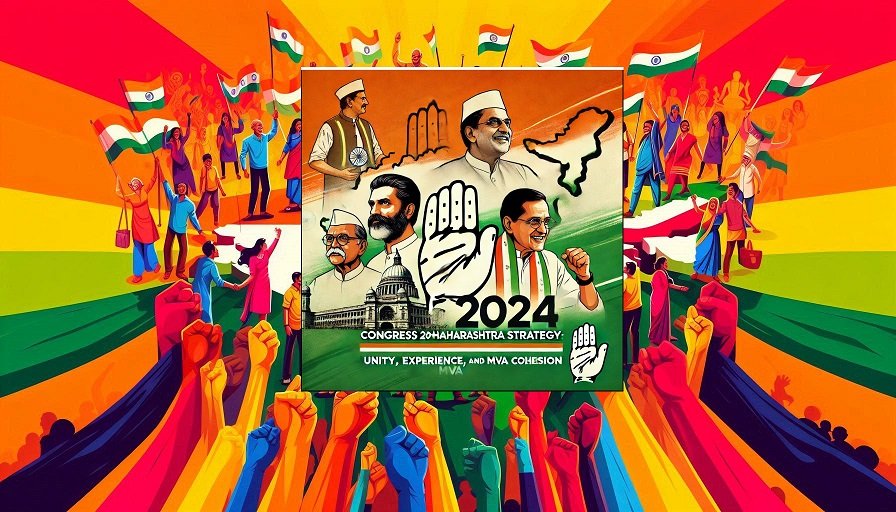As the 2024 Maharashtra Assembly elections approach, the Indian National Congress (INC) is gearing up for a critical political showdown. On the back of a series of electoral challenges, the Congress, as part of the Maha Vikas Aghadi (MVA) alliance with the Shiv Sena (UBT) and the Nationalist Congress Party (NCP), has unveiled its first list of 48 candidates. This marks the beginning of what is likely to be one of the most strategically fought elections in recent memory.

 The Congress’ strategy revolves around a combination of retaining strongholds, leveraging veteran leadership, and optimizing its alliance dynamics. At the core of its electoral calculus is the 85-85-85 seat-sharing arrangement among the three major MVA allies, designed to unify opposition forces against the BJP. However, behind this calculated approach lies a nuanced interplay of coalition politics, internal party dynamics, and the broader political landscape of Maharashtra.
The Congress’ strategy revolves around a combination of retaining strongholds, leveraging veteran leadership, and optimizing its alliance dynamics. At the core of its electoral calculus is the 85-85-85 seat-sharing arrangement among the three major MVA allies, designed to unify opposition forces against the BJP. However, behind this calculated approach lies a nuanced interplay of coalition politics, internal party dynamics, and the broader political landscape of Maharashtra.
Seat Sharing: A Strategic Necessity
The announcement of the seat-sharing formula—85 seats each for the Congress, Shiv Sena (UBT), and NCP—follows weeks of complex negotiations, underscoring the fragile yet necessary alliance between these parties. The MVA, which had come together after the 2019 elections to form the government, now faces the task of maintaining unity and ensuring electoral coherence.
The 85-seat formula has not been without its share of contention. Disagreements over the exact distribution, with the Congress initially pushing for 125 seats and the Shiv Sena (UBT) aiming for 100, reflect the underlying tensions within the alliance
Ultimately, the formula settled upon appears to be a compromise, with the remaining 33 seats allocated to smaller allied parties. Despite the challenges, the Congress is banking on this seat-sharing deal to counterbalance the BJP’s extensive organizational strength in the state.
The cohesion within the MVA is seen as crucial to not only winning key constituencies but also consolidating votes in areas where the BJP has a significant presence. However, coalition politics is inherently fraught with risks, particularly in a state as politically diverse as Maharashtra, where regional leaders and issues can dramatically influence voting patterns. The Congress will need to ensure that its alliance partners remain aligned on key issues throughout the campaign.
Veteran Candidates Lead the Charge
A notable feature of the Congress’ first candidate list is the inclusion of several heavyweight leaders who have long been associated with the party’s fortunes in Maharashtra. Key figures like Maharashtra Congress president Nana Patole (Sakoli), former Chief Minister Prithviraj Chavan (Karad South), and Leader of the Opposition Vijay Wadettiwar (Bramhapuri) are contesting from constituencies where they have a solid voter base
By fielding experienced leaders, the Congress hopes to tap into their established political capital while ensuring stability in regions that are considered Congress strongholds. The decision to retain 25 sitting MLAs is indicative of the party’s reliance on proven leadership to steer the campaign. However, this also signals a cautious approach, where the Congress has opted for continuity over risk-taking, likely in response to the BJP’s aggressive campaigning strategies in the state.
Veteran leaders are expected to play a dual role: securing their own constituencies and acting as regional campaign anchors to mobilize voters across neighboring districts. Their political clout, especially in rural and semi-urban regions, will be essential for Congress as it seeks to maintain a strong electoral presence amidst stiff competition from the BJP and its allies.
Challenges and the Road Ahead
While Congress enters the 2024 Maharashtra elections with a united front, several challenges remain. The BJP has made significant inroads in the state over the past few election cycles, and its formidable electoral machinery poses a tough challenge for the Congress-MVA alliance. The Congress must contend with the BJP’s well-organized ground-level mobilization, financial resources, and the charisma of its state leaders, as well as the appeal of Prime Minister Narendra Modi at the national level.
Additionally, Congress will need to address internal party issues, including factionalism and dissatisfaction among those leaders who may feel sidelined due to the seat-sharing arrangement. Balancing coalition politics while managing internal unity is a tightrope walk that will require careful handling by the party leadership.
MVA Cohesion: A Test of Unity
For the Congress, the 2024 elections will not only determine its political relevance in Maharashtra but also serve as a litmus test for the Maha Vikas Aghadi’s coherence as a long-term political project. The alliance, which came together to prevent the BJP from forming the government in 2019, now faces the challenge of transforming that success into an enduring political coalition.
With differing ideologies and political priorities, the Congress, Shiv Sena (UBT), and NCP must navigate potential flashpoints over regional issues, candidate selection, and campaign strategies. Whether the MVA can present a unified and cohesive front throughout the election campaign will be crucial in determining the electoral outcome.
At the heart of Congress’ strategy is the belief that a fragmented opposition will only benefit the BJP. By maintaining MVA solidarity and banking on its veteran leadership, Congress hopes to craft a winning formula. However, in a state as electorally unpredictable as Maharashtra, success will depend on much more than just alliances and experience—it will also require grassroots mobilization, effective campaigning, and a clear vision that resonates with the electorate.
The upcoming months will reveal whether Congress’ strategy can hold, or if the BJP’s organizational prowess will once again dominate Maharashtra’s political landscape.

, Rahul Gandhi next PM